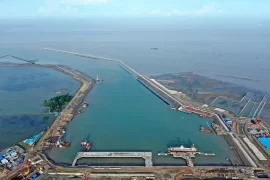Part I
On May 18, 2009, when Sri Lankan public TV stations were covering the breaking news that the army had found the dead body of Velupillai Prabhakaran – the leader of the Liberation Tigers of Tamil Ealam (LTTE), many observers struggled to reconcile with the footage of the corpse. VP, as Prabhakaran was known, almost always appeared in the media as a stout man with a revolver in his belt, standing or seated next to a red-and-yellow LTTE flag. Now his lifeless body with a visible bullet spot validated that the previous unconfirmed reports of his escape to India or Malaysia were only speculations. In fact, he was killed along with his family members and top leadership of the movement near or at Karayanmullivaikal, an area not far from VP’s headquarter in Puthukkudiyiruppu village. The next day, on May 19, 2009, Sri Lankan president Mahinda Rajapaksa delivered a ‘victory’ speech, in which he declared: “We have liberated the whole country from LTTE terrorism”. On that same day, Salvarasa Pathmanathan, one of the very few senior Tiger leaders left, sent an email to the Associated Press (AP) stating: “This battle has reached its bitter end. It is our people who are dying now from bombs, shells, illness and hunger. We cannot permit anymore harm to befall them. We remain with one last choice to remove the last weak excuse of the enemy for killing our people. We have decided to silence our guns.” This dramatic expiration of LTTE, particularly the annihilation of almost the entire leadership of the Tigers remains unprecedented in the contemporary global history of counterinsurgency. Not surprisingly, debates have surfaced over the ruthless nature of military campaign against the Tigers; questions are being raised regarding the exceptionality of Sri Lankan counterinsurgency model, and pundits are divided on the applicability of such model in other parts of the world.
Background of the conflict
Although the ethnic issue has dominated the discourse on Sri Lankan conflict, the root causes of Tamil-Sinhalese rivalries are much more complex than it commonly appears. The construction of mythical history by opposing communities, about 450 years of colonial experience, the divisive nature of post-colonial politics and, above all, unequal distribution of power and resources are some of the major issues that significantly contributed in shaping Sri Lanka’s conflict. The country has 19.2 million inhabitants, covers an area of 65,610Km. According to the last complete census carried out in 1981, before full-scale civil war, 74 percent Sri Lankans are ethnically Sinhalese who are overwhelmingly Buddhists and speak Sinhala language. The Tamils, who are mostly Hindu and speak Tamil language, are the largest minority (18.2 percent). Other minorities include Sri Lankan Moors (7 per cent), Burghers (0.3 per cent), and Malays (0.3 per cent).
The grand historical narrative of the Sinhalese typically begins with the arrival of the Indo-Aryans in the sixth century B.C.E. The Sinhalese national epic Mahavamsa (The Great Genealogy) describes how Buddhist religion came into Ceylon (until 1972, Sri Lanka was known as Ceylon) and how Buddhism was protected and promoted by different Sinhalese kingdoms as part of their national identity. Sinhalese are profoundly influenced by Theravada Buddhism (also dominant in Myanmar and Thailand) which is regarded as doctrinally conservative. Their language, Sinhala, is Indo-Aryan by origin but practiced only in Sri Lanka. Nevertheless, the patent disparities between ‘Kandyan’ (central highland) and ‘low country’ (coastal) Sinhalese substantiate the argument that Sinhalese are not a monolithic community. The kingdom of Kandy remained independent until 1818 which in turn enabled the Kandyans to preserve Sinhala culture and sustain traditional Buddhist education. Kandyan repudiated working for the foreigners and when the British captured the kingdom, English language hardly made inroads into the population. In this central highland, the Goyigama (cultivator/land owner) caste was at the top of the social hierarchy. On the other hand, inhabitants of the plains and the coast were deeply influenced by European rule and their missionary activities. New social hierarchies emerged as a result of the initiation of cash economy and modern bureaucracy; class became the new dominant force in place of the existing caste system. Therefore, by moving up in the social hierarchy, castes like Karava (the fishing caste, also referred to as Karaivar and Karaiyar) and Salagama (cinnamon peelers) began to challenge the hegemonic Goyigama caste. Despite these historical inner fissures within the community, however, the grand narratives and mythologies of ethnicity, language and religion have played critical role in shaping a ‘unified’ Sinhalese identity. Remarkably, regardless of being the majority in Sri Lanka, the Sinhalese consider themselves as ‘distinct minority in a sea of Dravidian Hindu Tamils’.
Sri Lankan Tamils are the descendants of the Dravidian invaders from southern India and they are mostly concentrated in the northern and eastern provinces. During the nineteenth century, the British brought the Indian Tamils to work on the coffee, tea and rubber plantations in Ceylon. They are considered to be the most marginalized group, constituting only five per cent of the population. Similar to the Sinhalese, regional rivalries and caste system have caused divisions among the Sri Lankan Tamils. For example, the Vellalars (agricultural cultivators and landowners) were the most prominent caste in the Jaffna peninsula. The Dutch allowed them to own slaves; the British preferred them as local agents. Conversely, Tamils from other castes often took to smuggling since they lacked social status, land or positions.
The Colonial Experience
Among the colonial powers, the Portuguese were the first to arrive in Ceylon in 1505. At that time, the island was ruled by three kingdoms: Kotte in the southwestern coastal region, Kandy in the inner highlands and one Tamil kingdom based in Jaffna. As a result of ruthless persecution of Muslims, Hindu and Buddhist inhabitants of the island, the Portuguese faced countless rebellions. Although they secured control over Kotte and Jaffna kingdom by the year 1619, the furious resistance from the Kandyans and the hostile combat terrain of the region around Kandy turned out to be impenetrable. The Portuguese promoted Roman Catholicism through missionary schools – thus implanting Christianity on the island. The native upper class adopted Portuguese as their official language and many even took Portuguese names. The Dutch took over the island from the Portuguese in 1656, showed more interests in promoting trade and commercial activities, discriminated the Catholics and supported the proselytizing activities of the Dutch Reformed Church. By 1760, the Dutch had set up 130 schools with nearly 65000 students. The interracial unions between Dutch men and local women gave birth to a thriving community whose descendants are now known as Burghers. The Dutch rule was short-lived and, in 1801 they ceded Ceylon to the British. The British ruled the island until 1948 and left a solid imprint on its politics, bureaucracy, economy and education. By 1815, they were able to bring the whole island under control of a single power for the first time since the twelfth century. The country was ruled by decree by its British Governor as one unit divided into provinces. In 1829, the Colebrooke-Cameron Commission, sent by the British Colonial Office, proposed revolutionary reforms for the local administration and judiciary. For instance, on the basis of the Commission’s recommendations, Legislative and Executive Councils were established with nominated members from the low country Sinhalese, the Kandyan Sinhalese, the Ceylon Tamils of the Northern, Eastern and Western Provinces, Plantation Muslims (Indian Tamils), Burghers and Europeans. But the most far-reaching policy-prescription was to standardize the curriculum in which English became the primary language. By the middle of the nineteenth century, the government funded and Christian missionary schools had expanded rapidly. However, the Tamil population got better access to education in view of the fact that a disproportionate number of missionary schools had been set up in the Jaffna peninsula where Tamils were a majority. For example, in 1885 there were about 819 schools in the country out of which 300 were in Jaffna alone. Furthermore, when the Colombo Medical College was set up in 1872, almost half the students were from Jaffna. Tamils made up more than 50 percent of the student body when the Technical College (1902) and Colombo University (1921) were established. Tamil students thus dominated higher education and began to occupy major positions in the government and bureaucracy. It is noteworthy that the first native commander of the Ceylon military and the navy came from Tamil community.
Another important consequence of the British rule is the divorce between state and religion, particularly after the subjugation of the Kandyan kingdom in 1815. The clerical establishment was incensed by the apparent assault on their heritage and culture and many rebellions against the British dominance, including the 1848 Matale rebellion, were coordinated by the Buddhists clerics, the Bhikkus. Their resentment intensified as the Christian missionaries greatly enhanced their proselytizing mission in the mid-nineteenth century. This anti-Christian attitude led to the birth of Buddhist revivalist movement which played significant role in shaping Sinhalese national consciousness. Later, in the early twentieth century, Buddhist organizations such as the All Ceylon Buddhist Congress (ACBC) and Sinhalese nationalist politicians demanded for the reinstatement of Buddhism to the status of state religion.
The Road to Majoritarian Politics
The introduction of modern education and the development of new capitalist class impacted heavily on the indigenous inhabitants of Sri Lanka. The Western educated, English speaking elites from both the Tamil and Sinhalese community formed a hegemonic class that had little connection with the lower classes. These inter-communal elite led the movement towards self-governance and formed the Ceylon National Congress (CNC) in 1919 to pressurize the British to bring about constitutional reforms. It is notable here that the first president of CNC was a prominent Tamil – Sir Ponnambalam Arunachalam. In 1931, on the recommendation of the Donoughmore Commission, the British brought about general elections and adult universal suffrage that eventually opened the door for majoritarian politics. The introduction of territorial representative system replaced the previous arrangement of communal representation in the Legislative Council. As a result, the multi-ethnic elite consensus broke down, and the Sinhalese as well as the Tamils increasingly began to assess their political and economic conditions through nationalist lens. A number of political parties also emerged in this period. In 1935, a Sinhalese party, the Sinhala Maha Sahba (SMS) was formed. That same year witnessed the emergence of two left wing parties; the Lanka Sama Samaja Party (LSSP) and the Communist Party (CP). In 1944, the first all Tamil party, the Ceylon Tamil Congress (CTC) was established which campaigned for a ‘50/50’ representation in the legislature However, the Soulbury Commission (1944-45) preferred territorial representation. In 1946, the United National Party (UNP) was formed by the members of the CNC. It was a center-right party, led by aristocrat families of Ceylon – the Senanayakes, Goonetillekes and Bandarnaikes. The leaders of UNP vigilantly negotiated with the Colonial administration that resulted in the Ceylon Independence Act of 1947. Elections for the first government of independent Ceylon were held in 1947 and the secular, pro-liberal UNP easily won it. Ceylon formally became an independent dominion within the British Commonwealth of Nations on February 4, 1948. Don Stephen Senanayake took office as the country’s first prime minister and the Soulbury Constitution, modeled after the Westminster Parliament, was legally put into practice.
[to be continued]
[1] Weaver, Matthew and Gethin Chamberlain. “Sri Lanka Declares End to War with Tamil Tigers.” Guardian, May 19, 2009.
[1] Ibid.
[1] Many modern Sri Lankan families have names with Silva, Perrera, Costa and Fernando.
The writer is an Assistant Professor at the Department of International Relations, University of Chittagong and Editor-in Chief of FAIR.







